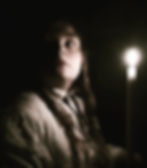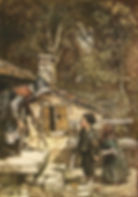Guest Post: Grimm and Gothic: The Romantic Darkness of Classic Fiction - By E.C. Hibbs
- L.L Hunter
- Apr 5, 2024
- 3 min read

Like many people, I was brought up on fairy tales. I adored the heroes and princesses, the enchanted forests, the castles and cottages and magical creatures. But despite being a fully-fledged Disney lover, I also read other versions, by the Brothers Grimm, Hans Andersen and Andrew Lang. Older versions. Darker versions. I don’t like to say ‘the original versions’, because there’s really no such thing. Stories evolve, piece by piece, depending on who is telling them, where, when, and for what purpose.
The purposes of fairy tales, in many cases, were more than just entertainment. They were told to warn against dangers, prepare for the future, and remember the past. When the Brothers Grimm wrote down the Germanic ones, it was with the intention of preserving them - and making sure they had consistency along the way. But no matter who was telling the earlier stories, “happily ever after” wasn’t always a regular feature. These stories can get dark - and not just the popular ones. If you want to be truly horrified, have a look at The Juniper Tree or The Robber Bridegroom (though maybe not when you’re eating!)

In one respect, you can argue that fairy tales are the most classic of classic literature. Aside from the sheer history behind them, their beautiful simplicity allows for a crucible of emotion. It’s a perfect canvas for imagination to take flight, conjuring up both the mystical and the dangerous. There is something distinctly unreal about them, which feels all the more real in the emotional response they draw from us.
I’d also argue that there’s another classic genre which features emotion and darkness in equal measure: the Gothic novel. Mysterious castles, dangerous nature, wonderful villains, forbidden love, people in disguise. Many of these things would also be right at home in a Brothers Grimm story - and they all appear in what is often classed as the first Gothic novel, The Castle of Otranto by Horace Walpole (1764).
I’ve loved Gothic stories for almost as long as fairy tales. To me, they felt like a natural extension as I grew older: similar motifs, but with a little more meat on the bones. The cautionary element wasn’t always there - some of these stories fell into sensationalism, or they were somewhat autobiographical; perhaps even a loose reimagining of historical moments. But there was something familiar about them: that romantic thread woven with something dangerous.
The first Gothic novels hit their height in the late 1700s, but in the early 1800s, there was a second generation on the rise, which went hand in hand with the Romantic movement. Around the same time, we have the first edition of Children’s and Household Tales (Kinder- und Hausmärchen) by the Brothers Grimm, with Hans Andersen’s first fairy tales following some 13 years later. 12 years later again, we have Jane Eyre, one of my favourite classic novels.

It was in re-examining Jane Eyre that I was reminded of fairy tales. Indeed, there are even a few references to the supernatural in the story: likenings to vampires and the gytrash, and Jane herself is compared to an elf or sprite. During this time, I was also preparing a talk on the history of fairy tales. As part of that, I touched on the Aarne-Thompson-Uther Index: a classification system which connects fairy tale elements. By applying it, one can see the multiple ways in which different stories can connect, like a giant tapestry of tales.
And a thought came to me. What if the ATU Index was applied not just to fairy tales and folklore, but also to the wider fiction which was coming out during the same time period? What if that tapestry could be Gothic as well as fantastical?
Right there, I had my own crucible for The Shade Between Shadows. Within it, I decided to weave not just a single fairy tale with a single Gothic novel, but multiple tales. Jane Eyre is the primary one, but there are elements from The Bride of Lammermoor and The Castle of Otranto too, which will be further expanded upon in the sequels. I made the initial fairy tale connections with Beauty and the Beast, Cinderella and Sleeping Beauty, but that spread to include almost 30 tales over the entire series.
My story would not have been possible without the influence of the ones which came before: those classics which all hold that romantic darkness. Whether they are fairy tales or novels, by the Grimms or the Brontes, there are delicious threads of danger, beauty and enchantment, all bound together by emotion.
I’ll always be a Disney kid at heart, but those parts of fairy tales and Gothic tales create a match made in heaven.
IMAGE CREDITS
Candlelight. E. C. Hibbs
Tower. E. C. Hibbs
Hansel and Gretel illustration by Arthur Rackham. Public domain.
Jane Eyre illustration by F. H. Townsend. Public domain.
--
E. C. Hibbs
She/Her






